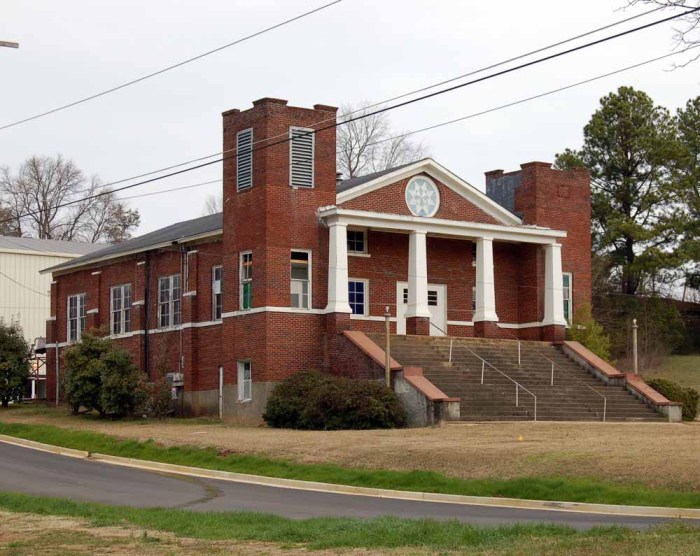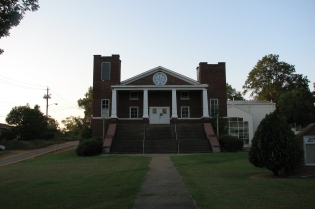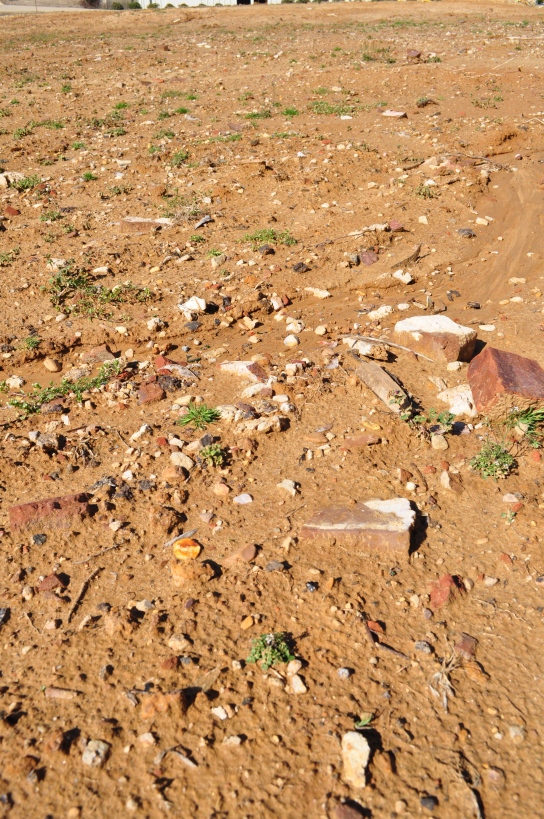Mississippi State University’s Homecoming weekend in Starkville, several days of celebration, partying, football, and…demolition. Well, not most Homecoming weekends, but the 2010 Homecoming weekend was a weekend of demolition. Griffin Chapel Methodist Church, the oldest African American congregation in Starkville, demolished their old church, the oldest African American church in the city, on that 2010 Homecoming weekend. The entire church, a brick and masonry structure occupying a Main Street corner for over eighty years, was demolished and the rubble hauled to the landfill in one day while the whole of Starkville watched the Bulldogs toss the pigskin around. That is one way not to raise the alarm of preservationists. In fact, several preservationist-inclined people did not notice Griffin Chapel’s disappearance for several weeks due to the quiet nature of its journey from religious sanctuary to landfill debris.
Although the histories available on Griffin Chapel Methodist Church are incomplete, cursory, and often contradictory, historians know that Griffin Chapel traces its origins to Reconstruction. According to both Luceille Liston Mitlin in her 1975 thesis “The Historical Development of Land Use in Starkville, Mississippi, a Small University City” and editor Sena W. Hardy in the official 1971 church history Griffin Chapel United Methodist Church, Starkville, Mississippi: To Serve the Present Age, 1867-1971, Griffin Chapel began as a Methodist brush arbor in 1867, the first religious congregation established by African Americans in Starkville. During the fleeting period when the African American Baptists of Starkville met at the brush arbor with the Methodists, the congregation was known as the Union Church. In 1871, the Baptists established Second Baptist Church, Starkville’s second-oldest African American congregation, taking their name in deference to the more established, white First Baptist Church. The Methodists abandoned the brush arbor in 1869, though the site still exists today as an African American cemetery on University Drive, a small plot of land sandwiched between a tanning salon and a photography studio; its few, small, scattered headstones contrasting with the numerous, well-kept monuments in the Odd Fellows Cemetery, Starkville’s historic white cemetery located across the street.
In 1869, the small Methodist congregation came under the auspices of the Methodist Missionary Society, which established a school for African Americans under the control of preacher/teacher Mack McLacklin. That school and the church congregation were housed in what Mitlin refers to as “[a] vermin-infested barn on the corner of Washington and Gillespie Streets.” McLacklin, a Northerner or “carpetbagger” in the parlance of the era, organized the school with the dream that it would morph into an African American college. To further this goal, he and the African American Methodist congregation in Starkville constructed a two story frame academy building at the corner of Greensboro and Louisville Streets, leaving the vermin-infested barn for the new frame structure in 1870.Because of his activities educating African Americans, as well as the African American cooperative store he established in the business district on Main Street, Starkville’s redeemers drove McLacklin from town and closed the school in 1878, part of a campaign in Oktibbeha County which saw most African American schools burned and their teachers driven from the area.
During the 1880s, the academy and Methodist Church building was replaced by a two story brick church building, with the old academy building possibly being destroyed in the post-Reconstruction terrorism practiced by white Mississippians against African Americans. Starkville’s African American Methodists occupied this brick church, the fourth building in their congregation’s history for those people keeping track, for only twenty years. This brick church burned circa 1900; like with so many things about African American history in this era when newspapers barely reported on African American events and they left few records of their own life, the precise date or cause is unknown.
At this time, Reverend Ira B. Griffin led the African American Methodists in Starkville, and he relocated the congregation to the corner of Main and Cushman Streets, where the congregation has remained ever since. The fifth building in the congregation’s history was constructed around 1900 and dedicated to its “pastor, Architect, and builder” Reverend Griffin. That circa 1900 church, brick like the previous structure, lasted only a generation; yet, its successor continued to carry the name Griffin Chapel.
In 1925, construction of the now demolished Griffin Chapel Methodist Church, the sixth building the congregation has occupied in their history, began with the laying of the foundation. The construction continued in stages over a few years; however, Hardy in her church history does not specify the completion dates for various parts of the church or the church as a whole, merely that the cornerstone was laid on September 2, 1926. That date is inaccurate; the Starkville News reported in their Friday, October 1, 1926 edition that the cornerstone would be laid the following Sunday, October 3 in front of a “record breaking crowd.”
Griffin Chapel had undergone numerous changes during its eight decades, most of which occurred in a 1970 renovation. During that 1970 renovation, new pews, light fixtures, carpets, and a central heating system (to replace the previous one installed in the 1950s) were installed in the church according to Hardy. Upon examination and the few photographs I have seen, I believe that the front door dated to the 1970 renovation. However, the intrinsic historical fabric of Griffin Chapel survived the renovation; the imposing massing which took advantage of the church’s sloping hillside site to impart a grand sense of scale, the front portico atop a monumental-style entrance stairway, the irregular but matching towers, the historic light fixtures, the original windows, all those components and more made Griffin Chapel an interesting and ambitious expression of Twentieth Century African American vernacular ecclesiastical architecture.
Unlike at the laying of its cornerstone, it was not a record breaking crowd that witnessed Griffin Chapel Methodist Church fall to the ground, masonry that had sheltered thousands parishioners during over eighty years of existence thudding into the Yazoo clay. In 1970, the congregation of Griffin Chapel Methodist Church decided to renovate their sanctuary instead of demolishing it. In 2010, that same congregation decided to demolish the church their parents, grandparents, and great-grandparents created, leaving a dirt patch at the corner of Main and Cushman Streets.
I hope other congregations in Mississippi do not follow the example set by the congregation at Griffin Chapel Methodist Church.
All photographs by W. White, unless noted. Please do not use without permission.
Categories: African American History, Churches, Demolition/Abandonment, Lost Mississippi, Starkville





Sad and DISGUSTING!
LikeLike
Nice church history and a very sad story. The number of churches in the black community whose history starts in a brush arbor is really interesting. The Damascus church (a founding church in black pentacostalism) outside Hazelhurst has a very similar story, for instance, something I encountered trying to reconstruct that neighborhood circa 1900 for a story about Robert Johnson (whose family lived there for decades prior to his birth).
LikeLike
Mound Bayou started with a brush arbor, and now at last count, they have 19 congregations of differing denominations in a population of 1500-2000 people. (Population count varies by what source, but closer to 1500 probably).
LikeLike
When I first read this early this morning, I was so stunned, I just sat looking at the computer screen rather dumbly I am afraid. What were the reasons for the decision to demolish?
LikeLike
What an amazing story of both the church’s history and the demolition. I’m also wondering why the congregation decided to demolish. Are they still an active church that relocated? If the building was remodeled in 1970 then I suspect that structurally it was sound. It would probably have adapted well to a re-use such as a community little theater. How sad that it is gone.
LikeLike
Griffin Chapel is still an active congregation and is located on the same site in the metal building located at the rear of the lot. The metal building can be seen in the various photographs.
LikeLike
That makes the story even more intriguing as to why they made the decision to demolish! When I looked at the after-picture I noticed that they did leave the brick sign with the two bushes on either side, so at least something was left.
LikeLike
My understanding, based on hearsay, is that the congregation decided the church was too expensive to maintain and built the metal building at the back to take its place, essentially sealing the older building’s fate, since the church definitely couldn’t maintain two buildings. I would be curious to know if the cost of the new building plus its maintenance has actually saved that much money. This was such a landmark and I wish the congregation would/could have pulled in outside support from the community to help maintain it, if that was the biggest issue. A big loss for Starkville.
LikeLike
There were grant monies to help with the damaged of historical buildings. No, there were members who drunk the kool-aide of the pastor who was there at the time. A number of us were working on funding for the repairing, but some rushed to destroy the church.
LikeLike
Being a resident of Starkville, the reason for the demolition of the church was because of extensive termite damage which made the building unsafe. With the new building already built, the congregation decided to demolish the older building.
LikeLike
No, there were a number of us that did not want it destroyed. We knew the history of the church. The damaged could have been fixed. Structures way older than Griffin still remain.
LikeLike
What is a brush arbor? Origins?
LikeLike
I also live in Starkville, and heard that money was an issue. Had not heard about the termites, but the building had become rather rundown looking from the street and was obviously in need of some work. I was very sad to see it go. There is another African American church in Starkville that I worry may suffer a similar fate on the corner of Russell and Gillespie.
LikeLike
I am a member of Griffin church and the church did not demolish the building due to money issues. The church was demolish because of old age. The church had weathered to badly to renovate another time. There was not a lot of options to the problem. The building behind the church is not the new church it is only a life center and a new church will be built were the old church once stood.
LikeLike
It could have been remodeled. Buildings older than Griffin have been remolded. It was demolished before some could try to get grants to remodel it. Years and years and years later, where is the new church? The pastor that convinced those to destroy it is long gone. It’s a sad day in history.
LikeLike
The entire congregation did not want it torn down. It was those who drunk the kook-aide of the Pastor at that time. It broke my heart as a member of Griffin to see it torn down. Shortly afterwards, that very pastor left Griffin.
LikeLike